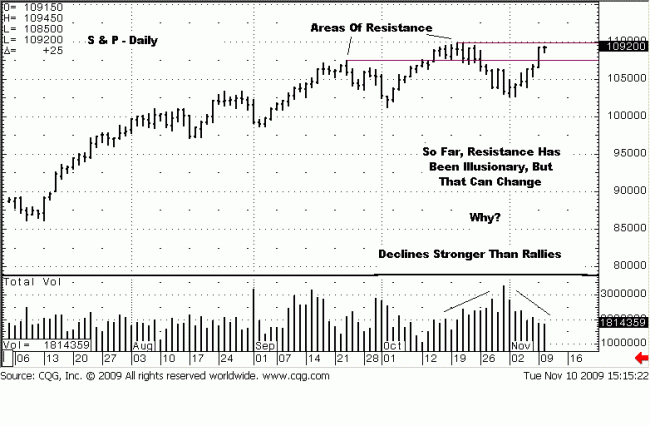Tuesday 10 November 2009
What is missing in the S & P to indicate that a correction will ensue? Sellers,
plain and simple. There has not been a concerted effort of selling to
overtake buying activity and turn the trend down, at least not in the past
month or so. 23 September looked like a potential high, and it lasted until
12 October. That high then became a point of resistance.
New highs occurred in mid-October, but price moved sideways in a trading
range as opposed to rallying higher. The October highs also became a point
of resistance, both of which are shown on the chart below. The question
posed is, will the resistance points hold? Will price turn around and start
going down? Or will new highs be in the cards?
No one can say with certainty what will happen, but we can look at a few signs
and begin to draw some conclusions as to expectations and be prepared to
act accordingly.

It is obvious that the initial resistance from 23 September gave way readily
when price rallied with a wide range bar and high end close on Monday.
Volume was not that strong, but in an environment where buyers are in control,
price can rally on less volume. What it demonstrates is a lack of sellers. The
lack of volume does indicate that buyers are less in number, but not in
strength of moving price directionally. That brings us to today’s activity, and
to the crux of questions posed as to what will happen, price-wise?
What stands out immediately, [when you know what to look for], is the very
narrow range for Tuesday’s activity. It is the narrowest range bar since 10
August, and it tell us that sellers were present to keep buyers from extending
the rally higher, right at an important point of obvious resistance. However,
price closed on the high, and that says that buyers remained in control. If
sellers were in control, the close would have been on the lower end of the price
range.
What is known is that sellers had a superb opportunity to wrest control from
weakened buyers, but as weak as the buying was, it was greater than the
selling efforts. The edge goes to buyers, even if only by default. What is
difficult to answer is, why sellers have not taken over?
The selling waves have been greater and stonger than the buying waves.
The way we know this is through the pick-up in volume, which is shown on the
next chart. It is quite obvious that volume was much greater on the decline
that on the recent rally. Look back to the decline at the end of September,
and it is also apparent that volume was greater on the down days than the
rally days. These are the few signs, observable facts, that help draw some
conclusions.
It can also be observed that the rallies of the past two months have made the
least amount of upside progress, and that says the energy behind the rally
has weakened. It does not mean the rally has ended, just that it is weaker.
Couple that with the other factual observations, and the stage is set for a
potential change in trend. Of course, new buying on strong volume could
enter the picture tomorrow and change everything, but until is does, we have
to base the observations on what is, or has been.
Tuesday’s small range is a red flag, a warning that sellers could step in and
take over. If it is to happen, it has to happen now! Our guess is that it will
not for sellers had every advantage going their way after the second hour or
trading, but it was lost. They were simply not able to do anything, and the
strength of the market direction continued up from a lack of sellers.
What makes the most sense, given the weakened condition of buyers, is for
the market to make a new probe higher to see what kind of buying potential
exists above the October highs. At the same time, the new high will clean out
weak shorts with stops resting just above. If no demand shows up to continue
price higher with a wide range and strong volume, sellers will see the failure of
buying power, and that may be enough to bring them out in force and start to
overwhelm the buyers. That would be a form of ending action that is needed
to turn the tide. The alternative was given already. New demand would enter
on a sharp rally and on strong volume.
The most logical possibilities are no known, and it becomes a simple matter
of being prepared to act on whichever one develops. Market activity will clarify
the picture. It always does, eventually.




